With large expanses of prairie grasslands, several large rivers, and lakes, as well as Wind Cave and Badlands National Parks, South Dakota’s beautiful scenery is home to a wide variety of terrestrial birds and waterfowl.
Summers can be extremely hot here, often exceeding 100 degrees Fahrenheit, whereas long periods of the winter can remain under the grip of frost.
Overall, the best season to see ducks in South Dakota is during the spring and fall migratory seasons, when huge flocks pass through the state on their way to and from their main breeding grounds further north.
Some of the flocks remain here to breed during the summer, and a few of the more hardy species enjoy South Dakota as their winter grounds. Some ducks will even remain here the whole year round.
With some fascinating species in the mix, let’s take a closer look together at the wild world of South Dakota’s ducks!
Ducks That Can Be Seen in South Dakota Year-round
Mallard
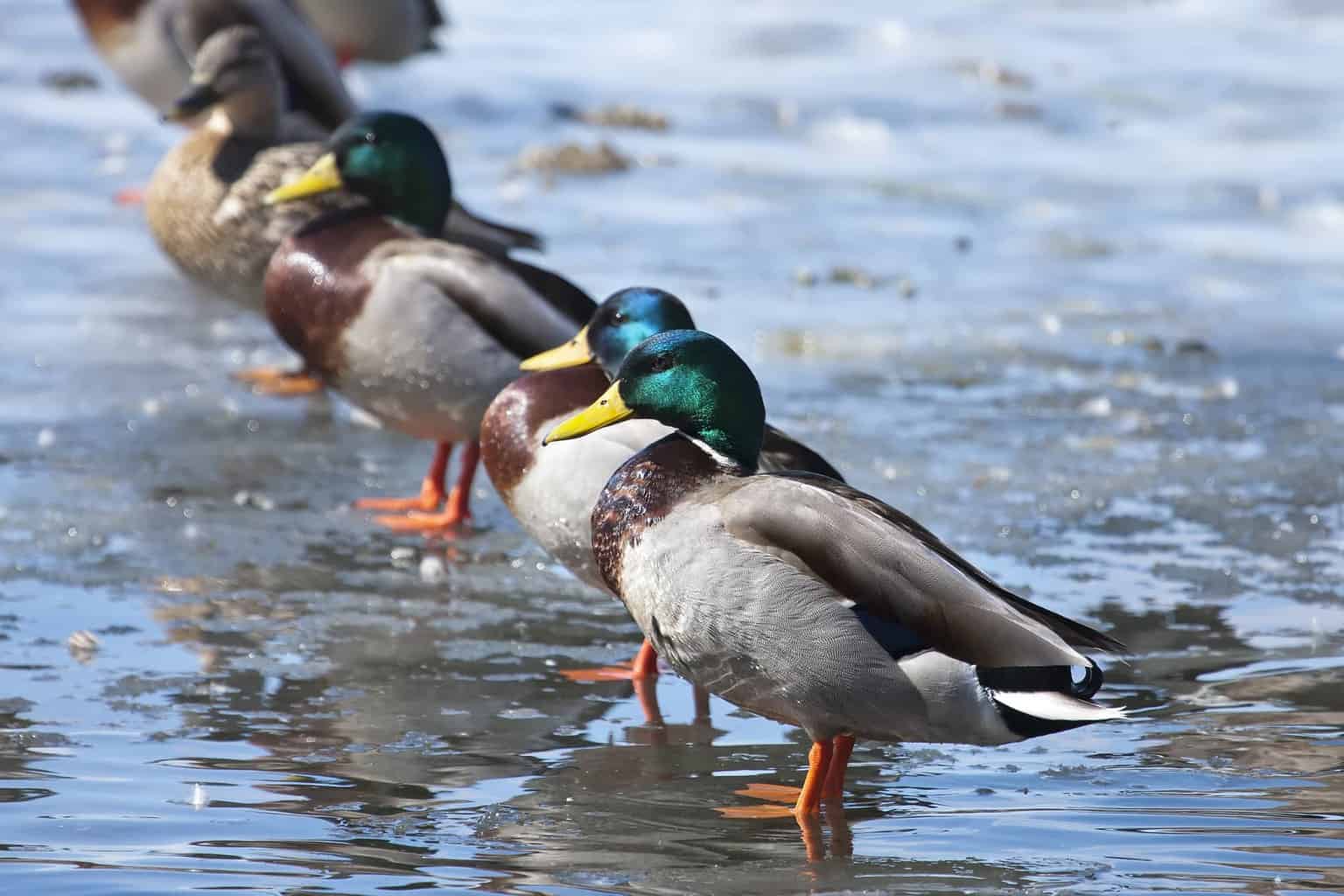
- Scientific Name: Anas platyrhynchos
- Length: 19.7 – 25.6 in
- Weight: 35 – 45 oz
- Wingspan: 32.3 – 37.4 in
Not surprisingly, the ever-present Mallard is the most frequently seen duck in South Dakota. They can be seen all year, but are more common during the summer and especially during the migratory seasons.
Mallards are one of the largest dabbling ducks and can live for over 20 years! They are also the forefathers of many domestic duck varieties.
If you enjoy feeding water birds, Mallards will often be some of the first to swim over. But did you know that bread may not be the best food to feed ducks? According to experts, raw grains, peas, and even split grapes are a better choice for their health.
Gadwall
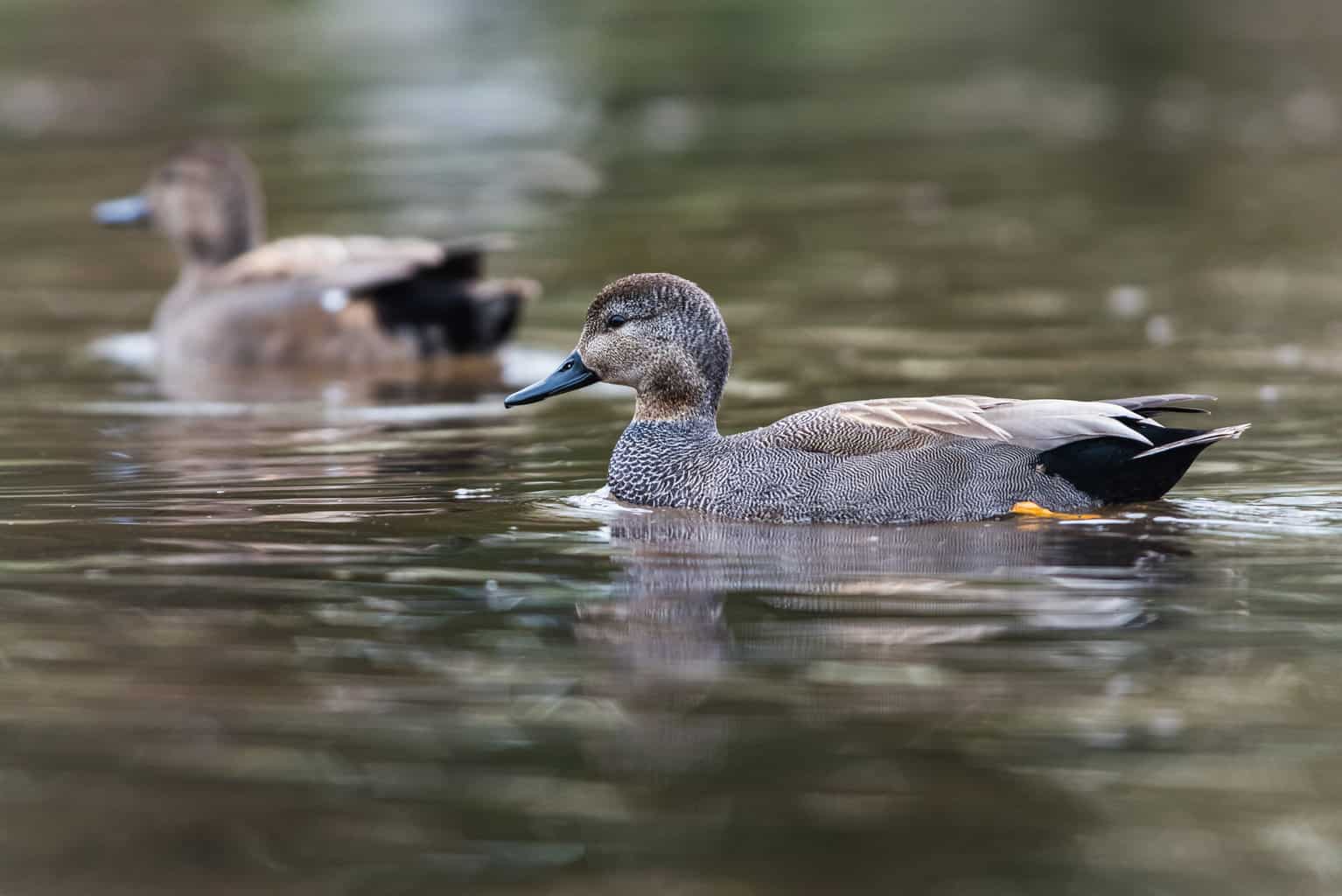
- Scientific name: Mareca strepera
- Length: 19 – 23 in
- Weight: 29 – 35 oz
- Wingspan: 31 – 36 in
Gadwalls are not the most colorful of duck species, and, from a distance, can be confused with a female, or non-breeding male mallard.
Seen in flight though, Gadwalls can be distinguished by the white rectangles on their upper wings, which are very different from other related duck species.
These large dabbling ducks are most commonly seen in South Dakota during the migratory season, but some pairs will stop to nest here among wetlands and marshes containing dense vegetation.
To see a Gadwall in this state during the winter is a possible, but rare occurrence since most flocks will move further south during the colder months.
Wood Duck
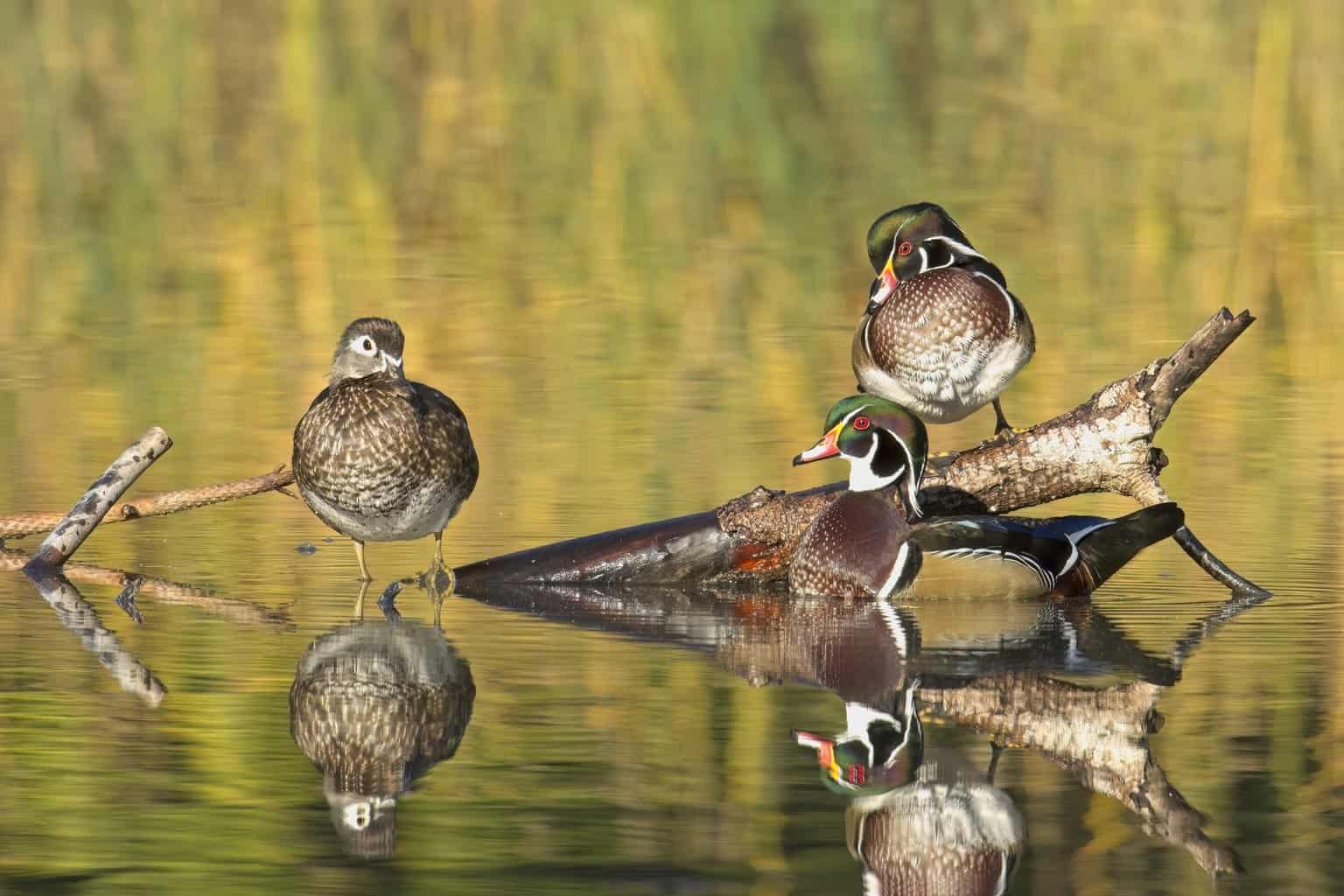
- Scientific Name: Aix sponsa
- Length: 18.5 – 21.3 in
- Weight: 16 – 30 oz
- Wingspan: 26.0 – 28.7 in
The outrageous green tuft and bright red eyes and bills of the Wood Duck have earned them the reputation as one the most colorful and comical looking of all North American duck species.
Wood Ducks can commonly be found breeding in the eastern half of South Dakota, and a few may even remain along the eastern border throughout the winter too.
Instead of nesting among vegetation like most ducks, Wood Ducks prefer to nest up to 50 feet in a tree cavity or nest box, from which their poor young must jump almost as soon as they hatch! Talk about a leap of faith!
Northern Pintail
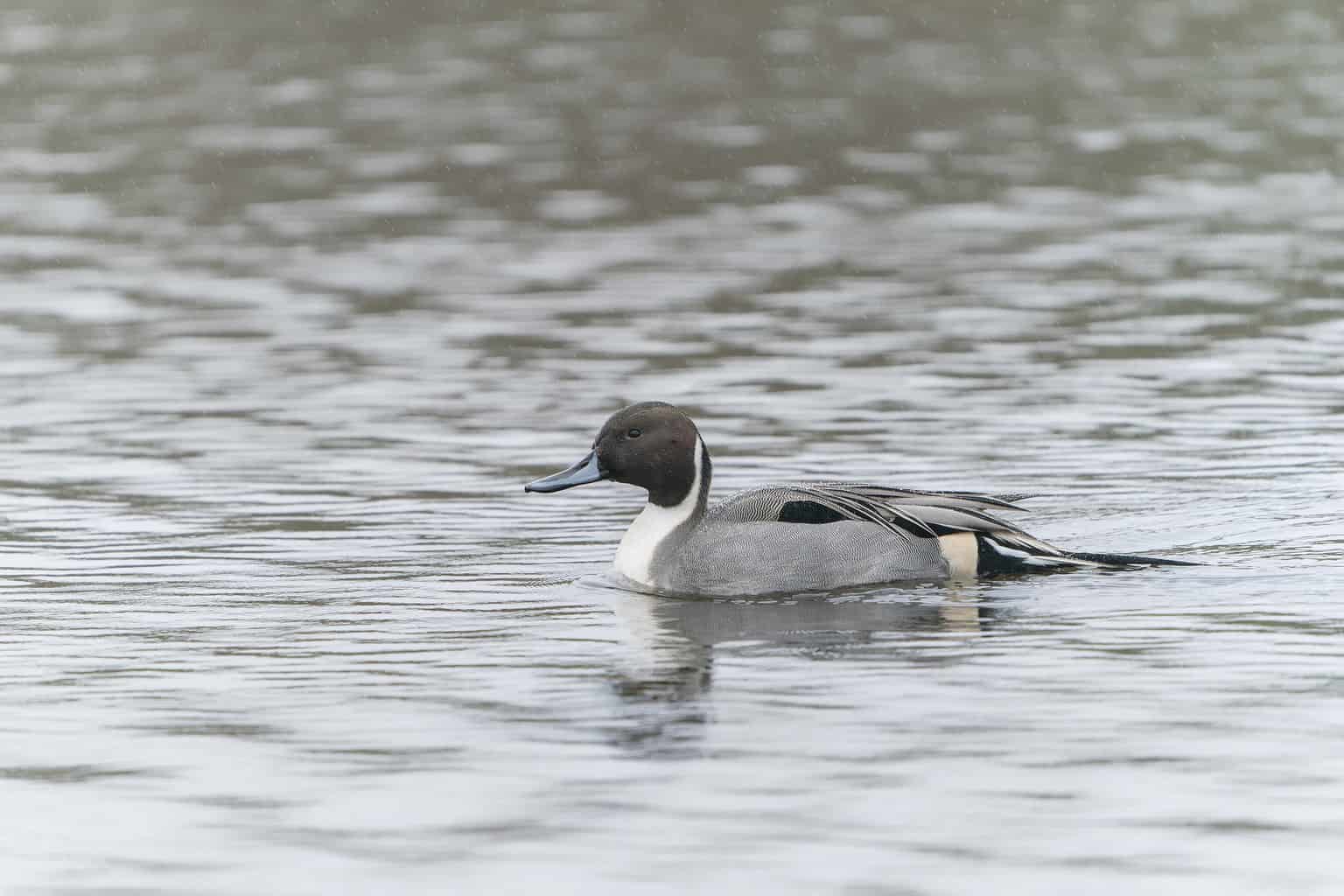
- Scientific Name: Anas acuta
- Length: 20 – 26 in
- Weight: 25 – 36 oz
- Wingspan: 29 – 35 in
South Dakota lies somewhere in the middle of the breeding and winter ranges of the Northern Pintail duck, meaning they can be seen both during summer and occasionally in winter too.
Northern Pintails tend to prefer fairly remote wetlands, the edges of lakes, ponds, and other bodies of water to habitats near human habitation. But that doesn’t stop them from flocking to agricultural fields during the late summer and fall to clean agricultural fields of barley, corn, wheat, and rice leftovers!
These ducks are fast on the wing, with an extensive range that stretches from Central America, all the way up to the tip of Alaska, and even parts of Greenland too.
Green-winged Teal
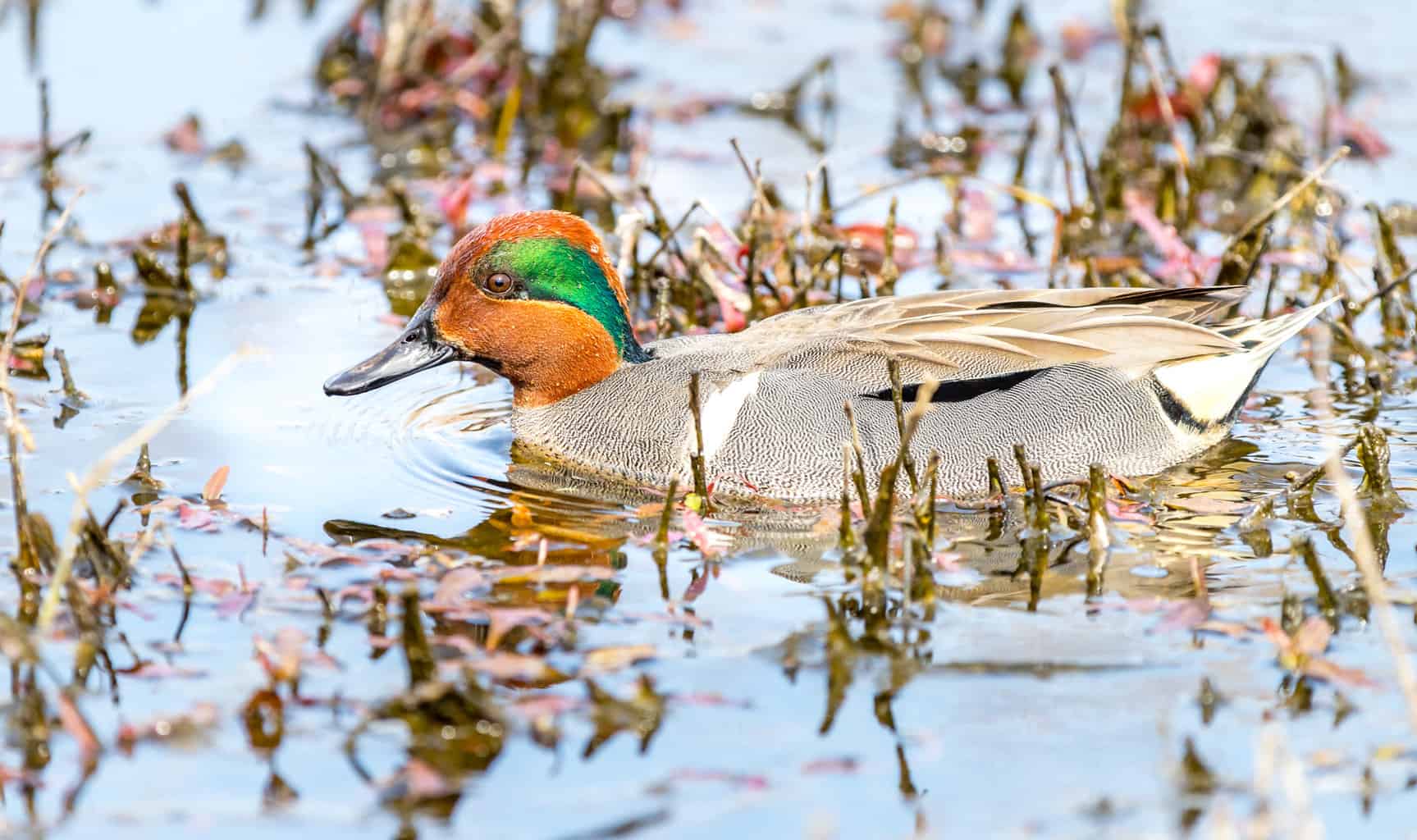
- Scientific Name: Anas crecca
- Length: 12.2 – 15.3 in
- Weight: 6 – 17.6 oz
- Wingspan: 20.5 – 23.2 in
The Green-winged Teal is the smallest duck in North America, being on average only 14 inches long, and usually weighing less than a pound!
But their size doesn’t stop them from making big impressions with their beauty. The male Green-winged Teal in his breeding plumage with his dark cinnamon red head and iridescent green mask is a treat to behold.
Green-winged Teals are dabbling ducks that, according to the Sibley Guide To Birds, prefer to feed in shallow water or mudflats by skimming the surface with their bill.
- Sibley Guide To Birds, 2nd Ed
- Sibley, David Allen (Author)
- English (Publication Language)
Last update on 2024-04-25 / Affiliate links / Images from Amazon Product Advertising API
American Wigeon

- Scientific Name: Mareca americana
- Length: 16.5 – 23.2 in
- Weight: 19 – 46 oz
- Wingspan: 33.1 in
American Wigeons are medium-sized ducks that are mainly spotted during the migratory seasons in South Dakota, when you can see large flocks of them passing through the state, sometimes stopping off on arable fields to fuel up on leftover grains from autumn harvests!
Small numbers of them do also breed in the state though, and a few can even be seen throughout mild winters, especially in the southwest of the state.
While they may sometimes be difficult to spot, The Sibley Guide To Birds reminds us to listen out for the male making their distinctive, airy whistle: ‘wi-WIW-weew’ or ‘Wiwhew’!
Redhead
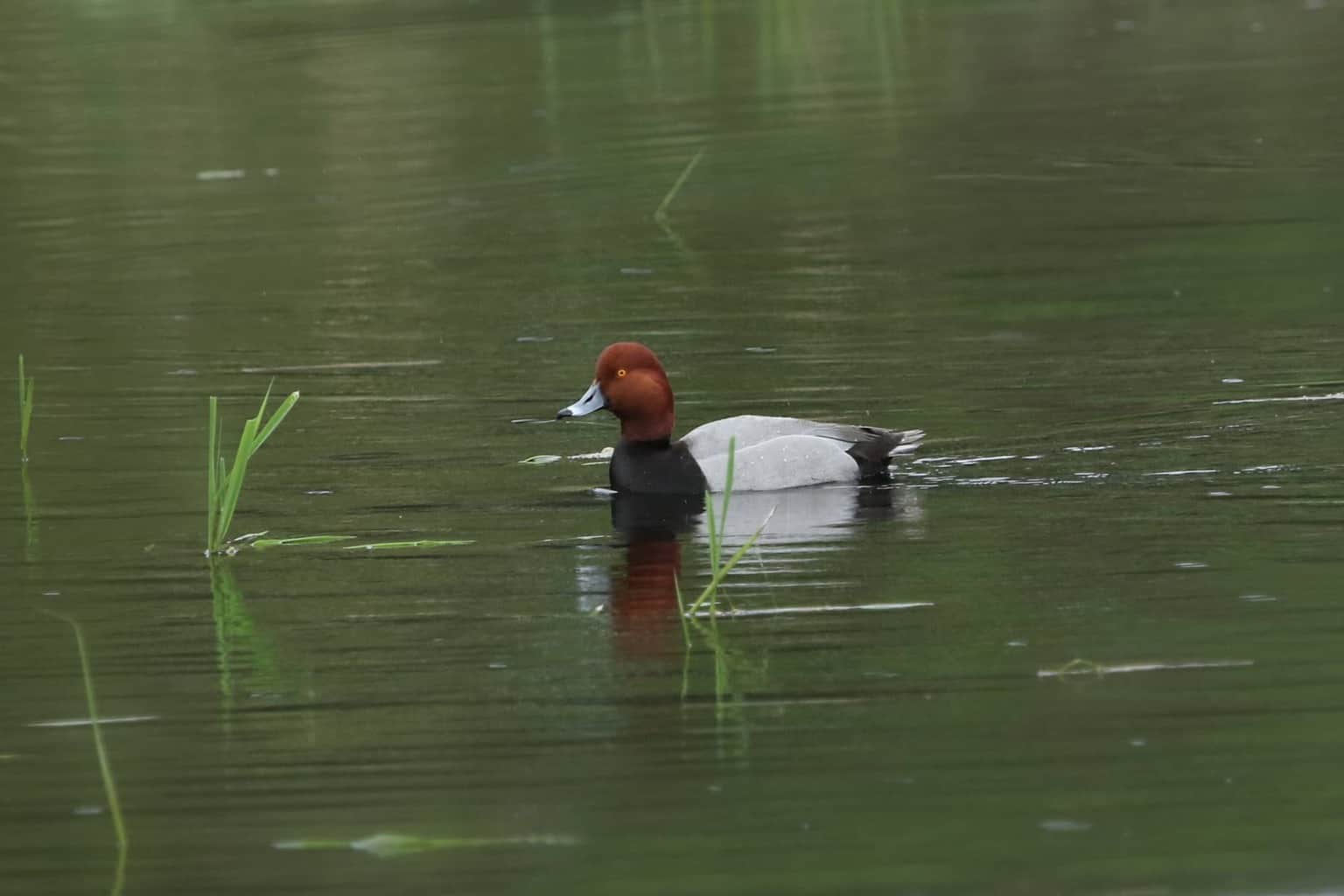
- Scientific Name: Aythya americana
- Length: 18 – 22 in
- Weight: 29 – 41 oz
- Wingspan: 29 – 35 in
South Dakota is a common breeding ground for Redhead ducks, and a few will sometimes stick around for winter too, especially in the southeasternmost part of the state. Larger numbers of them can be seen during spring and fall migrations.
Male Redheads can indeed be identified by their bright cinnamon-red head and golden eyes, whereas female Redheads simply have light brown plumage all over.
Redheads are diving ducks but don’t tend to dive as deeply as many divers, behaving more like dabbling ducks in their feeding habits.
Lesser Scaup
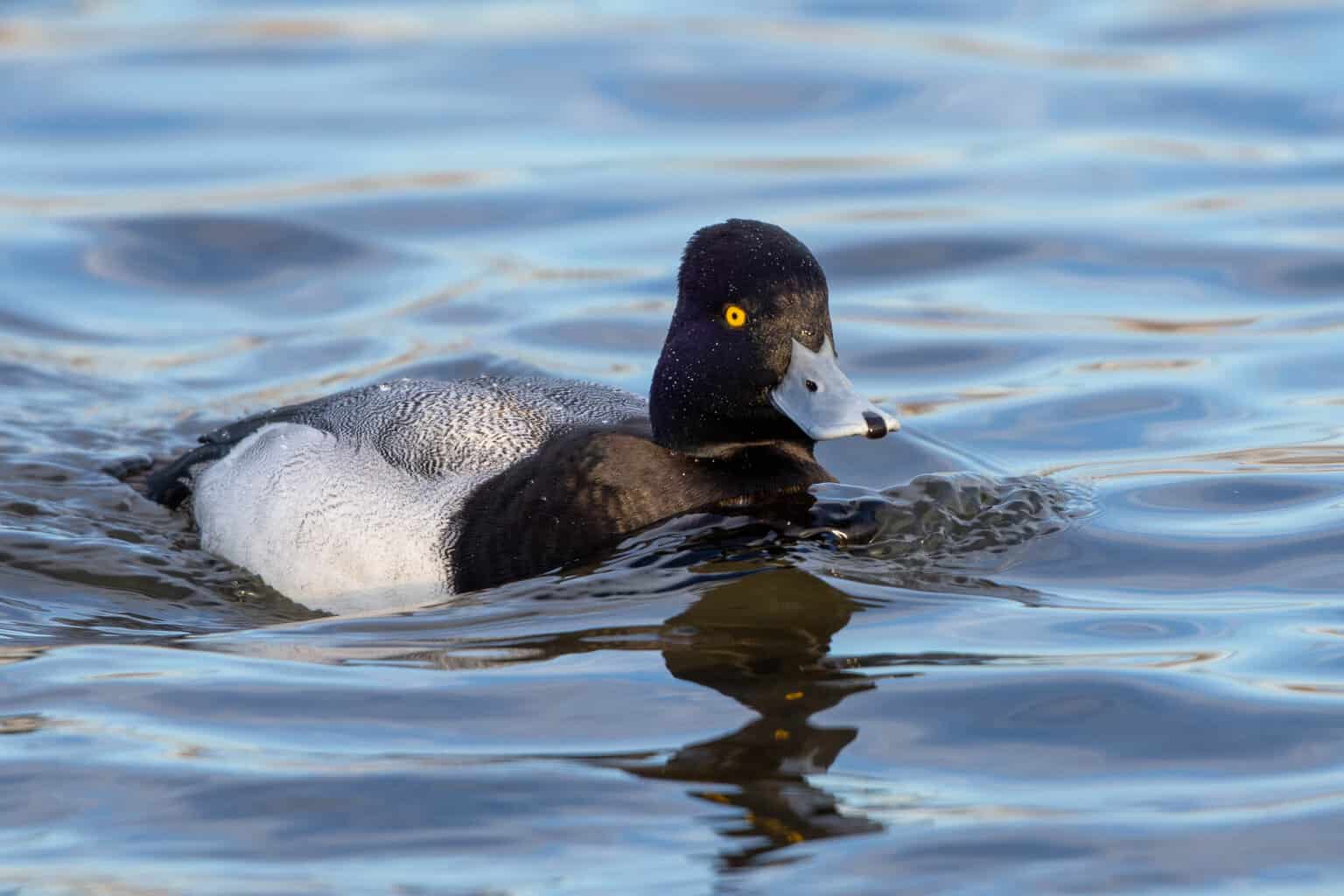
- Scientific Name: Aythya affinis
- Length: 15 – 18 in
- Weight: 32 – 40 oz
- Wingspan: 24 – 33 in
Lesser Scaups are the most common diving duck in North America, sometimes gathering in flocks that number thousands, and forming huge floating rafts on large lakes and reservoirs.
The difficulty in identifying Lesser Scaups lies in their similarity with their cousin the Greater Scaup – both having a mottled-grey back, deep black head, and golden eyes.
Luckily in South Dakota, this is less of a problem because whereas Greater Scaups are only occasional winter visitors, Lesser Scaups prefer to spend time in the state during the breeding season, with only a very few birds staying through the winter.
Ring-necked Duck
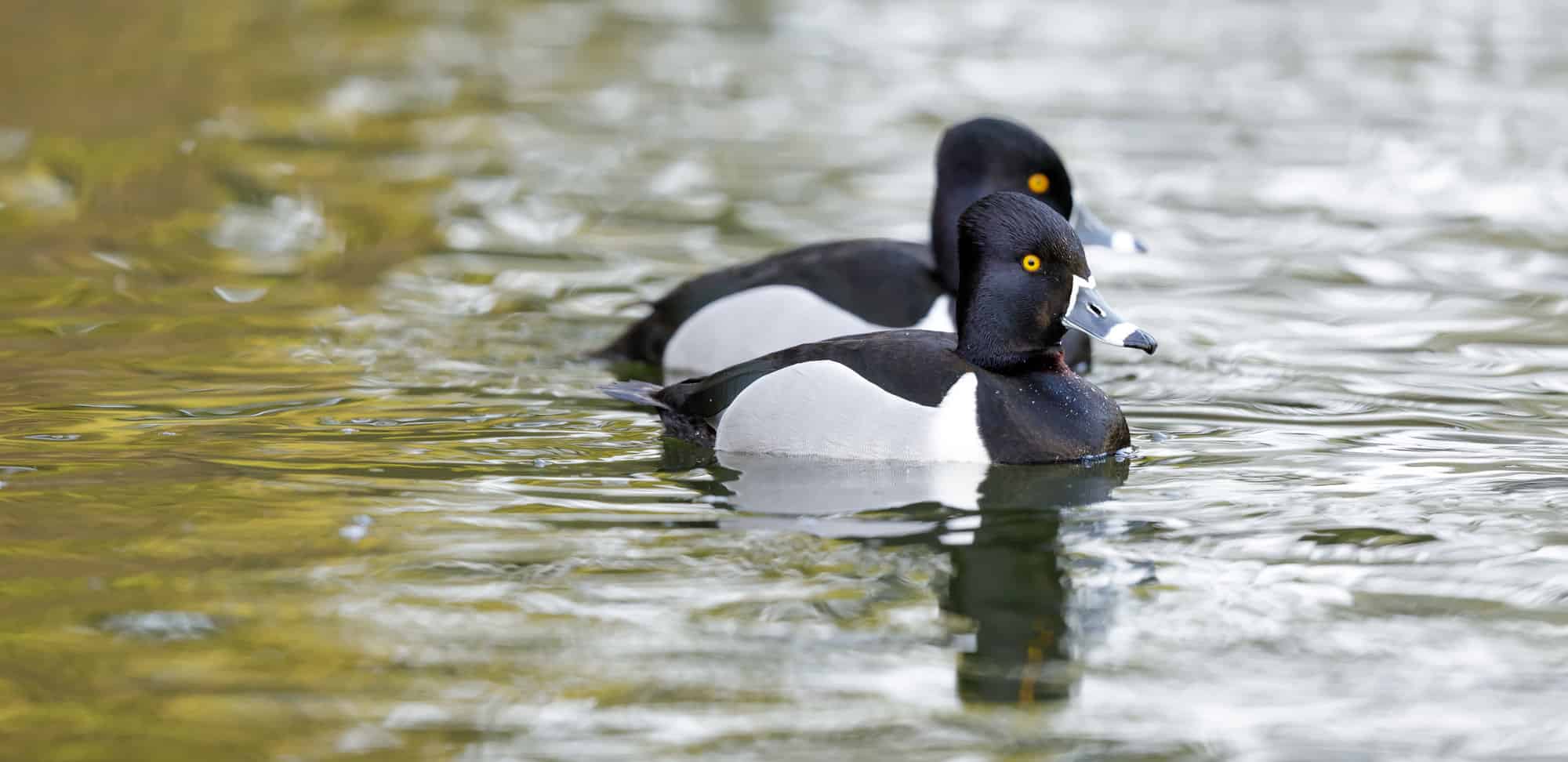
- Scientific Name: Aythya collaris
- Length: 14 – 18 in
- Weight: 21 – 32 oz
- Wingspan: 24 – 30 in
Ring-necked Ducks are mostly winter residents in South Dakota, but a few of them stick around in the northeast of the state for breeding too.
‘Ring-necked’ is not a very apt name for these ducks, whose faint cinnamon-colored ring around their neck is difficult to make out.
A more reliable way to identify them is by the white band that runs around the top of the bill in both males and females and the steep, jet-black head in males with bright golden eyes.
Although Ring-necked ducks are divers, they behave more like dabbling ducks in the water, feeding in shallow water on pondweed, wild rice, and small aquatic animals.
Canvasback
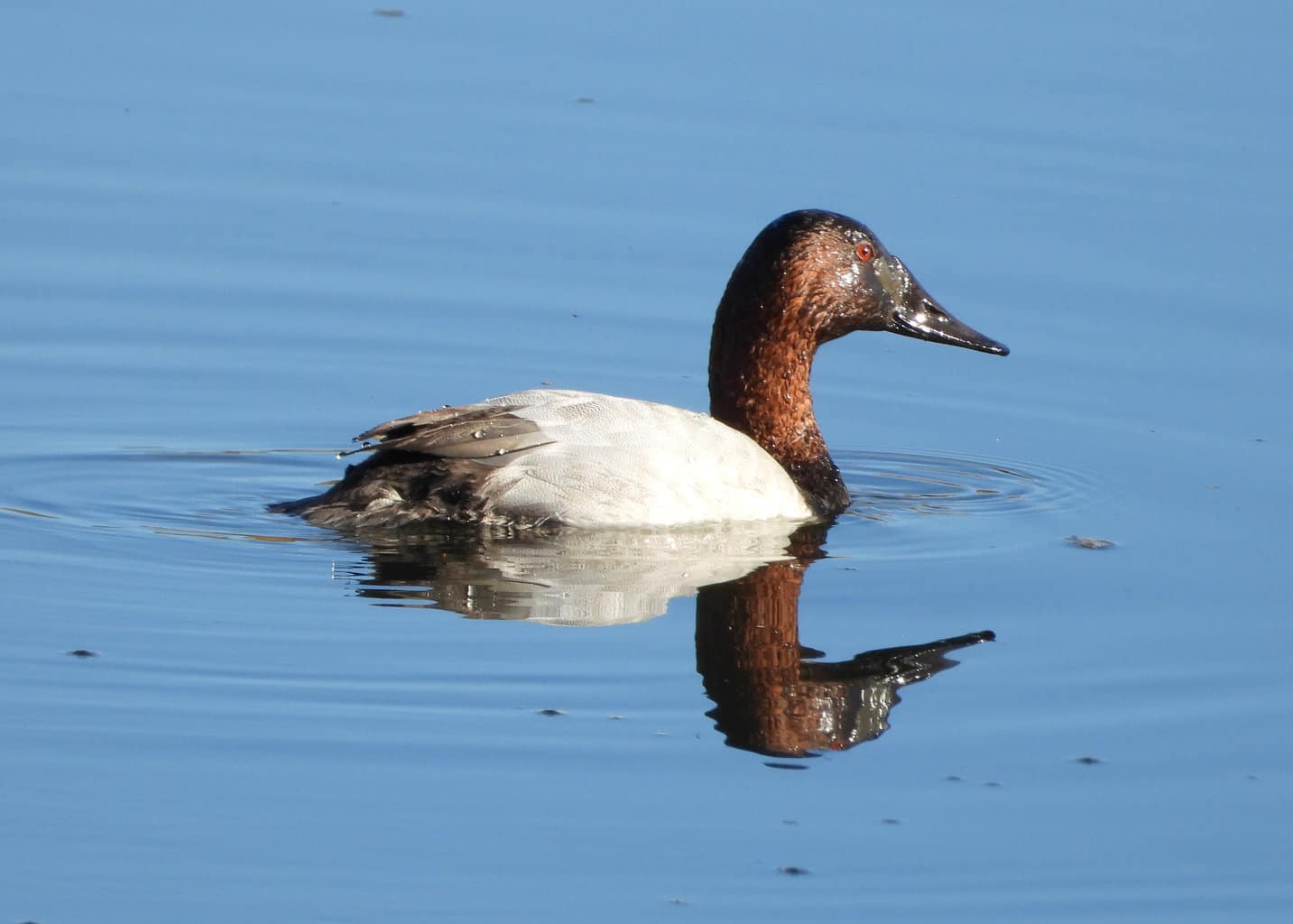
- Scientific Name: Aythya valisineria
- Length: 19 – 24 in
- Weight: 36 – 58 oz
- Wingspan: 28 – 36 in
Canvasbacks are big, powerful diving ducks that can fly at over 70mph and dive to at least 30 feet in the water.
Their backs are indeed a creamy canvas white or light gray and male Canvasbacks are also famous for their bright red eyes.
Canvasbacks can be found in South Dakota year-round, but are more common during the migratory seasons and in the summer months when they breed mostly in the south and western parts of the state. A few may also overwinter in the south.
Common Merganser
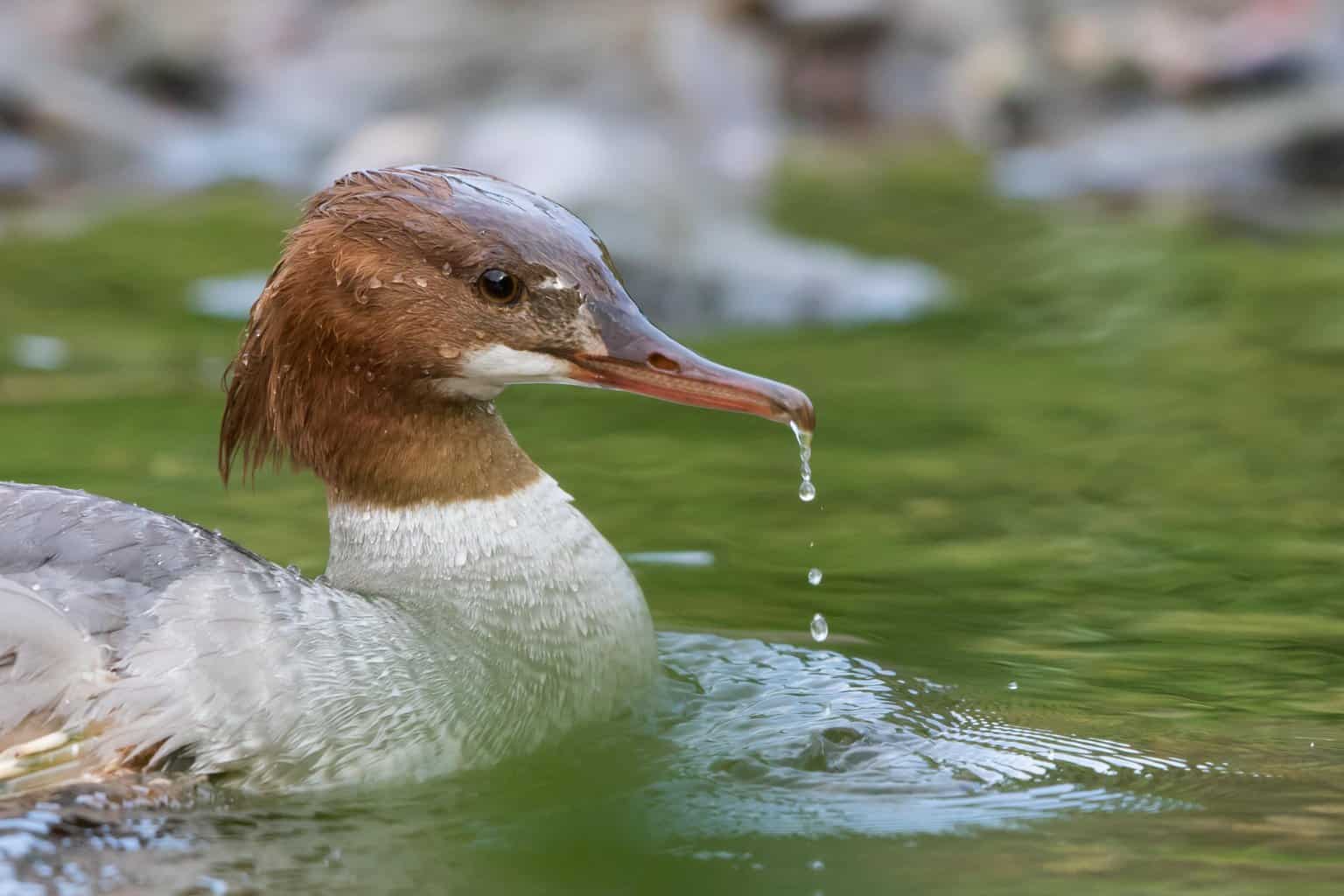
- Scientific Name: Mergus merganser
- Length: 22 – 27 in
- Weight: 45 – 60 oz
- Wingspan: 31 – 37 in
Common Mergansers are the largest of the three merganser species in North America, with a wingspan of up to 37 inches. As fierce predators, they love to catch fish with their long, serrated bills, which has earned them their other common name ‘fish duck’.
While Common Mergansers can be seen all year round in South Dakota, they’re much more common in winter, when they’re ticked off on 10% of bird watcher’s report cards, as opposed to just 1% in the summer.
A colorful and elegant duck, the males have a lovely green head, bright red bill, and mostly white body. Females have brown, slightly tufted heads and grey bodies.
Hooded Merganser
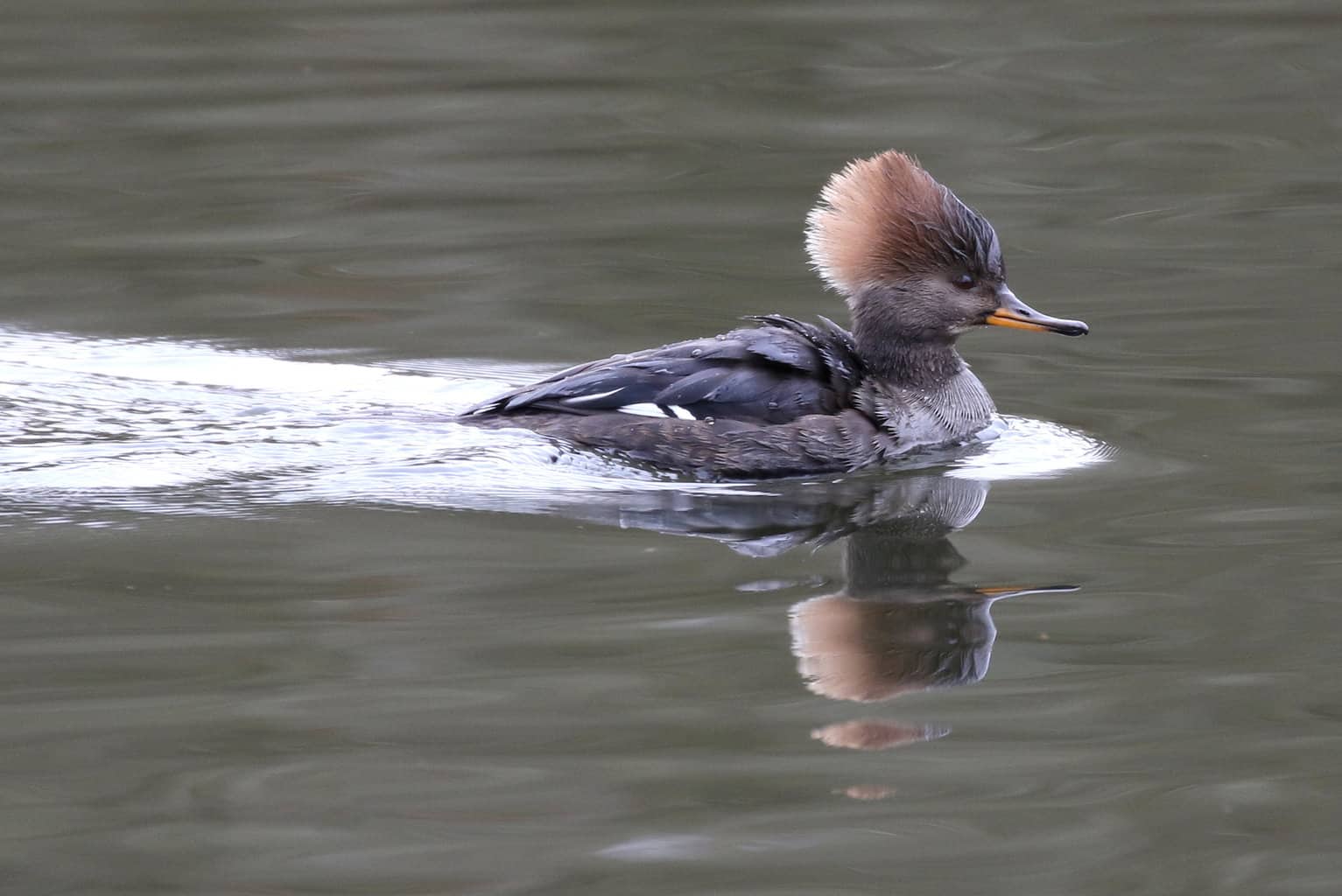
- Scientific Name: Lophodytes cucullatus
- Length: 16 – 19 in
- Weight: 21 – 32 oz
- Wingspan: 24 – 26 in
Hooded Mergansers are also reported more frequently on birdwatchers’ checklists in winter than during the summer, but unlike the Common Merganser, these ducks are never very common in South Dakota.
From a visual standpoint, these ducks must be some of the most impressive in America. The male’s exotic, white, hood-like crest can be truly stunning during the breeding season, and the female also possesses a spiky brown crest resembling a mohawk!
As omnivorous ducks, Hooded Mergansers have a broad-ranging menu consisting of aquatic insects, fish, crustaceans, snails, frogs, aquatic plants, and seeds.
Ducks Only Seen In South Dakota During Summer
Northern Shoveler

- Scientific Name: Spatula cyanoptera
- Length: 14 – 17 in
- Weight: 11 – 16 oz
- Wingspan: 24 – 30 in
As you might expect from their name, Northern Shovelers are famous for their shovel-like beaks that they use to sift through weedy pond water in search of plankton and aquatic plant seeds.
From a distance, you might confuse the iridescent green head of the male Northern Shoveler with that of a Mallard, but his chest is very different, being white in color.
As you get closer, you’ll also spot their enormous, wide bills, which distinguish them from all other ducks.
Northern Shovelers are most often seen in South Dakota during the migratory seasons, but some of them also settle to breed in the state. In the winter, they fly to the Southern United States and Central America.
Blue-winged Teal
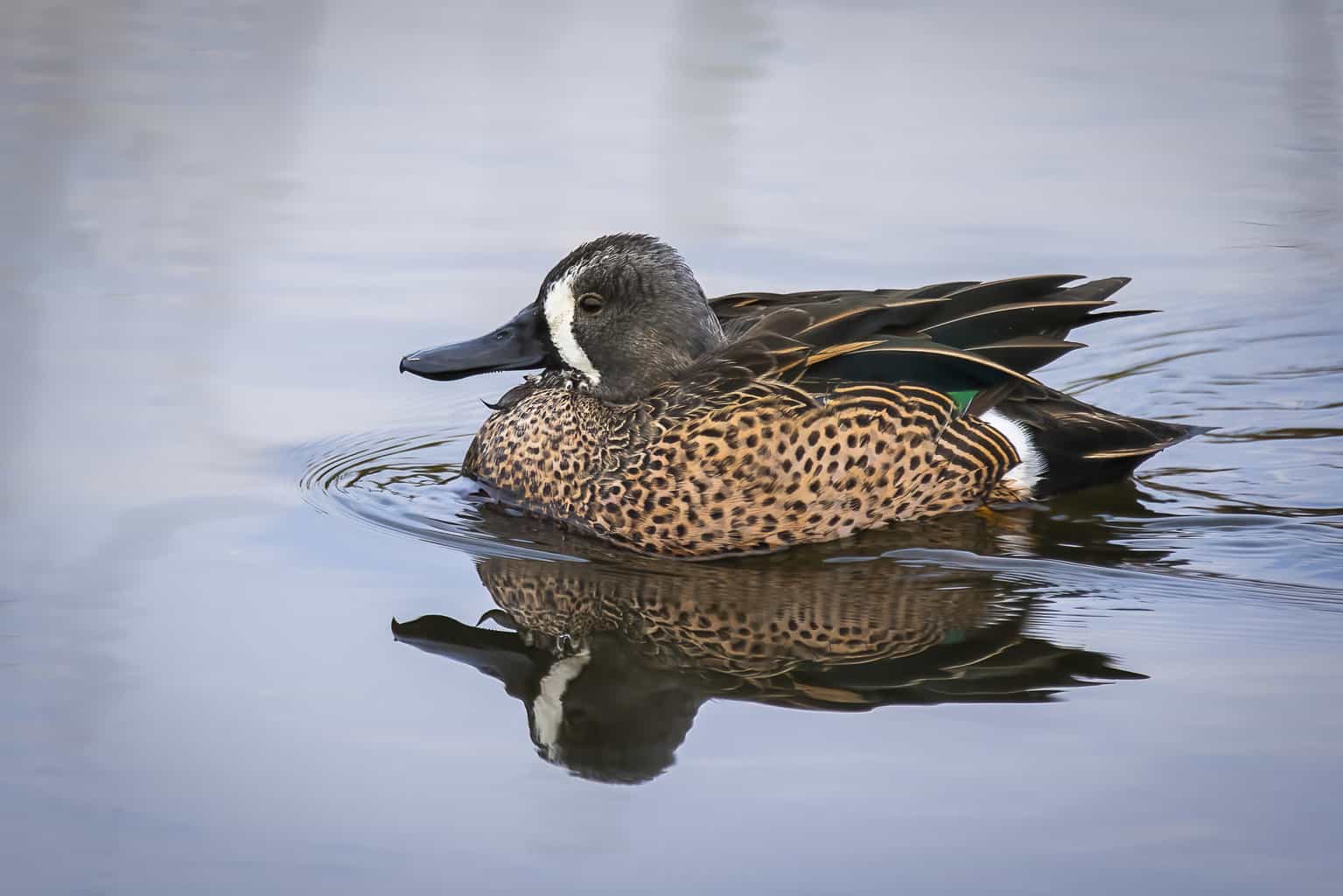
- Scientific Name: Spatula discors
- Length: 15 – 17 in
- Weight: 10 – 19 oz
- Wingspan: 23 – 31 in
South Dakota is right in the middle of the common breeding grounds of the Blue-winged Teal, which nests right across the United States and the southern half of Canada.
In the winter, these birds are long gone, opting to reside instead in the southern United States, and Central and South America.
Blue-winged Teals are the second most common duck in North America, runner-up only to the Mallard, and are one of the most frequently seen ducks in South Dakota during the summer.
As a common duck species, flocks of these birds are often targeted by duck hunters. Thankfully, numbers are being carefully monitored to ensure a relatively stable population can persist.
These ducks prefer shallow wetland habitats where they feed mostly on aquatic vegetation and the occasional aquatic insect.
Cinnamon Teal
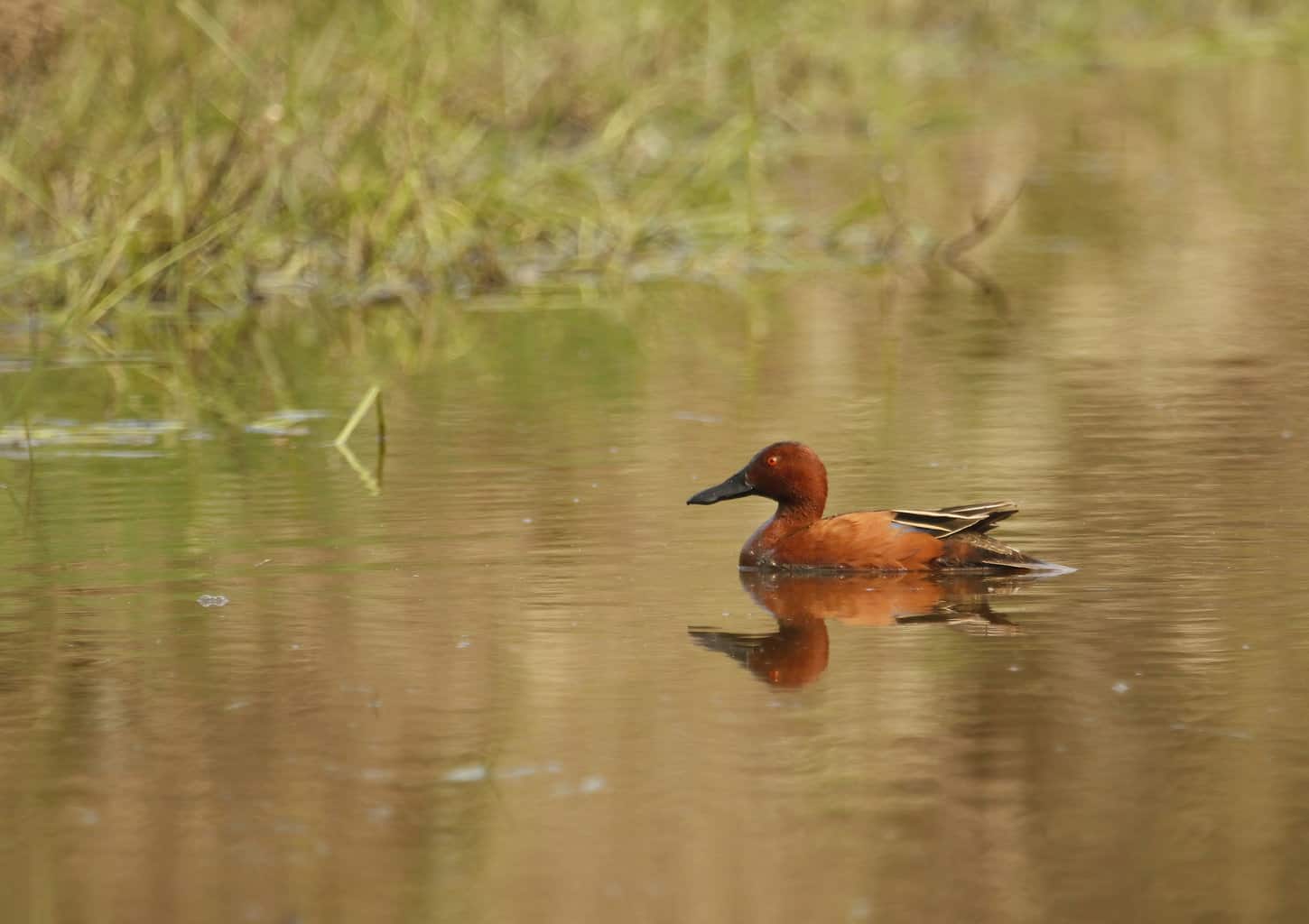
- Scientific Name: Spatula cyanoptera
- Length: 14 – 17 in
- Weight: 11 – 16 oz
- Wingspan: 24 – 30 in
The gorgeous-looking male Cinnamon Teal, swimming alongside the mottled-brown female in the breeding season is a lovely sight. True to his name, the breeding male is cinnamon red over much of his body, with bright red eyes.
South Dakota lies right on the edge of the Cinnamon Teal’s favored nesting grounds in the western states, but some pairs can be found nesting in wetlands along the western border of the state.
Very sadly, Cinnamon Teal numbers have been declining over the past 50 years due to habitat loss as modern farming methods have drained or contaminated much of the wetlands that these birds rely on.
Ruddy Duck
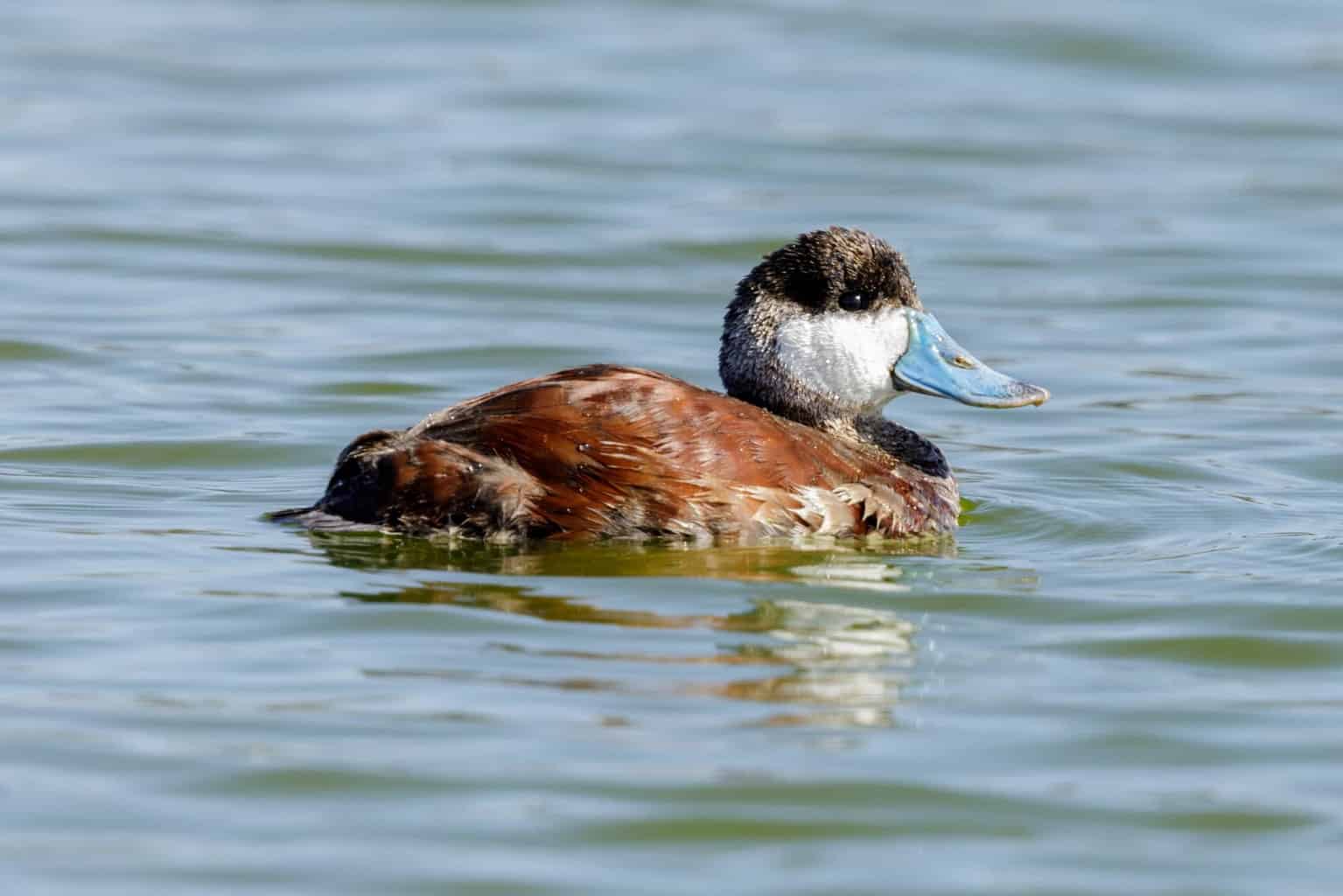
- Scientific Name: Oxyura jamaicensis
- Length: 14 – 16 in
- Weight: 12 – 30 oz
- Wingspan: 21 – 24 in
Another duck with amazing-looking breeding plumage, a male Ruddy Duck’s shiny deep brown feathers on his back, bright white cheeks, and a bright blue bill makes it difficult to mistake this unique species of duck for any other.
Ruddy Ducks can be found from late February all the way up until early December in South Dakota, spending just the very coldest months of the winter in more southerly states shortly before returning again.
Ruddy Ducks are highly omnivorous and spend their time diving for aquatic vegetation, insects, and shellfish.
Ducks in South Dakota in Winter
Common Goldeneye
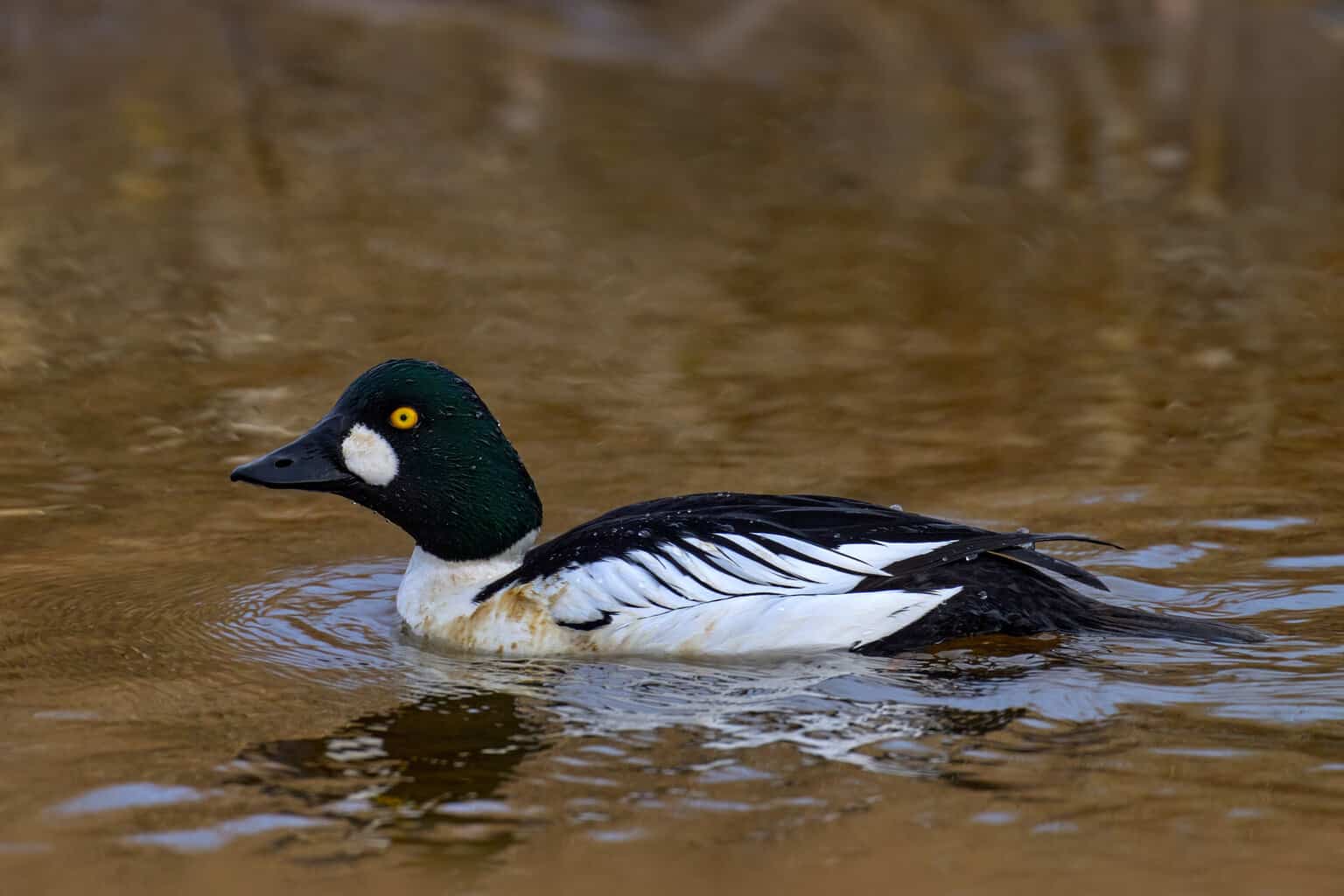
- Scientific Name: Bucephala clangula
- Length: 15.8 – 20.1 in
- Weight: 21 – 45 oz
- Wingspan: 30.3 – 32.7 in
Common Goldeneyes are a hardy duck and the second most frequently seen species in South Dakota during the winter, after the Mallard.
This may be surprising, because they’re completely absent in the state between Mid-May – October when they’re nesting further north, mostly in Canada.
Goldeneyes are one of the duck species that like to nest in tree cavities and so would naturally rely on ancient standing trees to host them in the spring.
Luckily they will also accept human-made nest boxes as an alternative where natural nesting sites have become hard to find.
Bufflehead
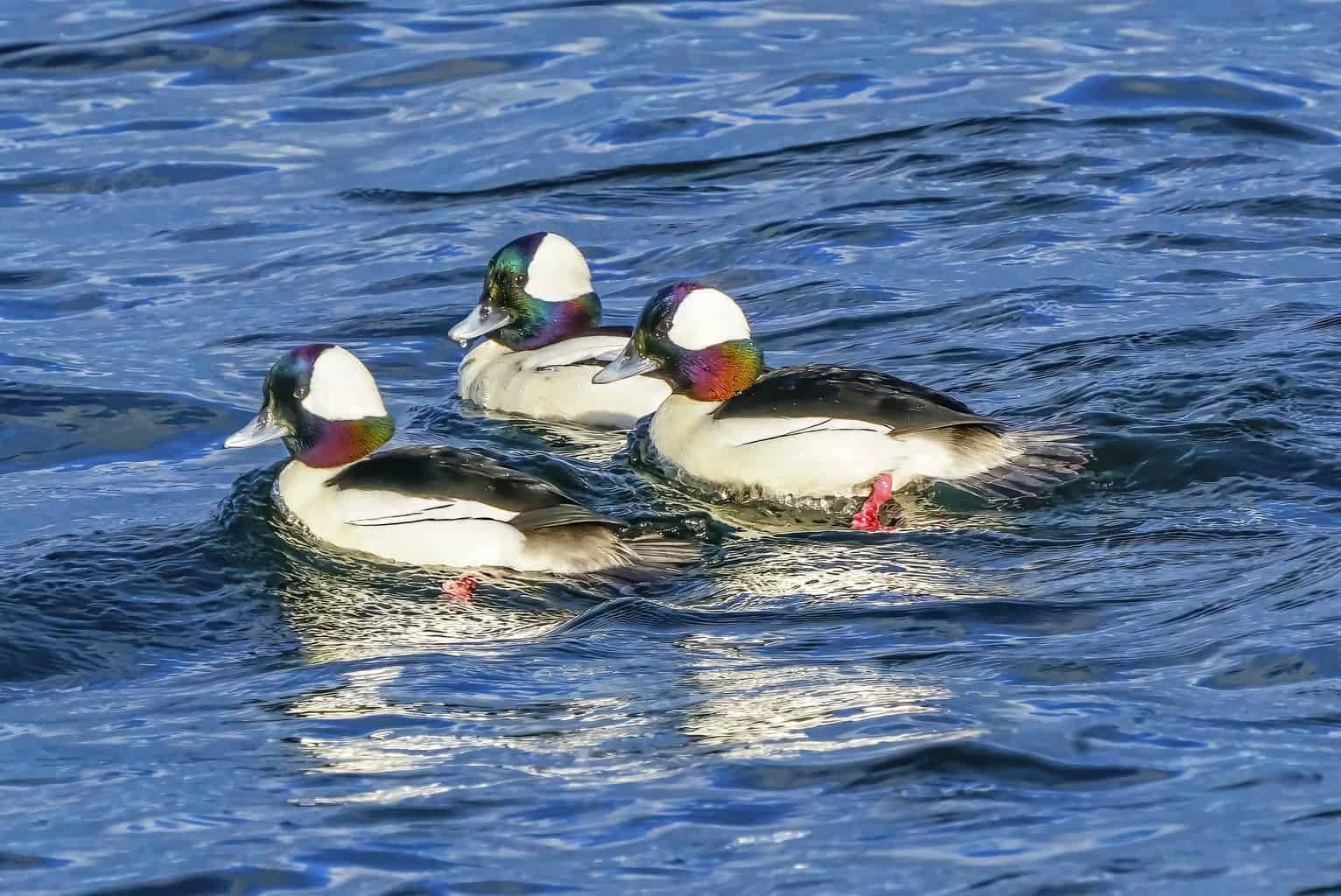
- Scientific Name: Bucephala albeola
- Length: 13 – 16 in
- Weight: 11 – 21 oz
- Wingspan: 20 – 24 in
Buffleheads are very small ducks with surprisingly large-looking heads. The large white patch behind the eyes in males is very distinctive, and it’s hard to confuse them with any other ducks.
Buffleheads are mainly transitory birds in South Dakota, but will sometimes settle, especially in the southwest of the state during the winter.
In summer they’re entirely absent, but may occasionally breed in the neighboring state of North Dakota.
Buffleheads are divers and spend a lot of their time underwater searching for mollusks, crustaceans, and aquatic insects.
Red-breasted Merganser
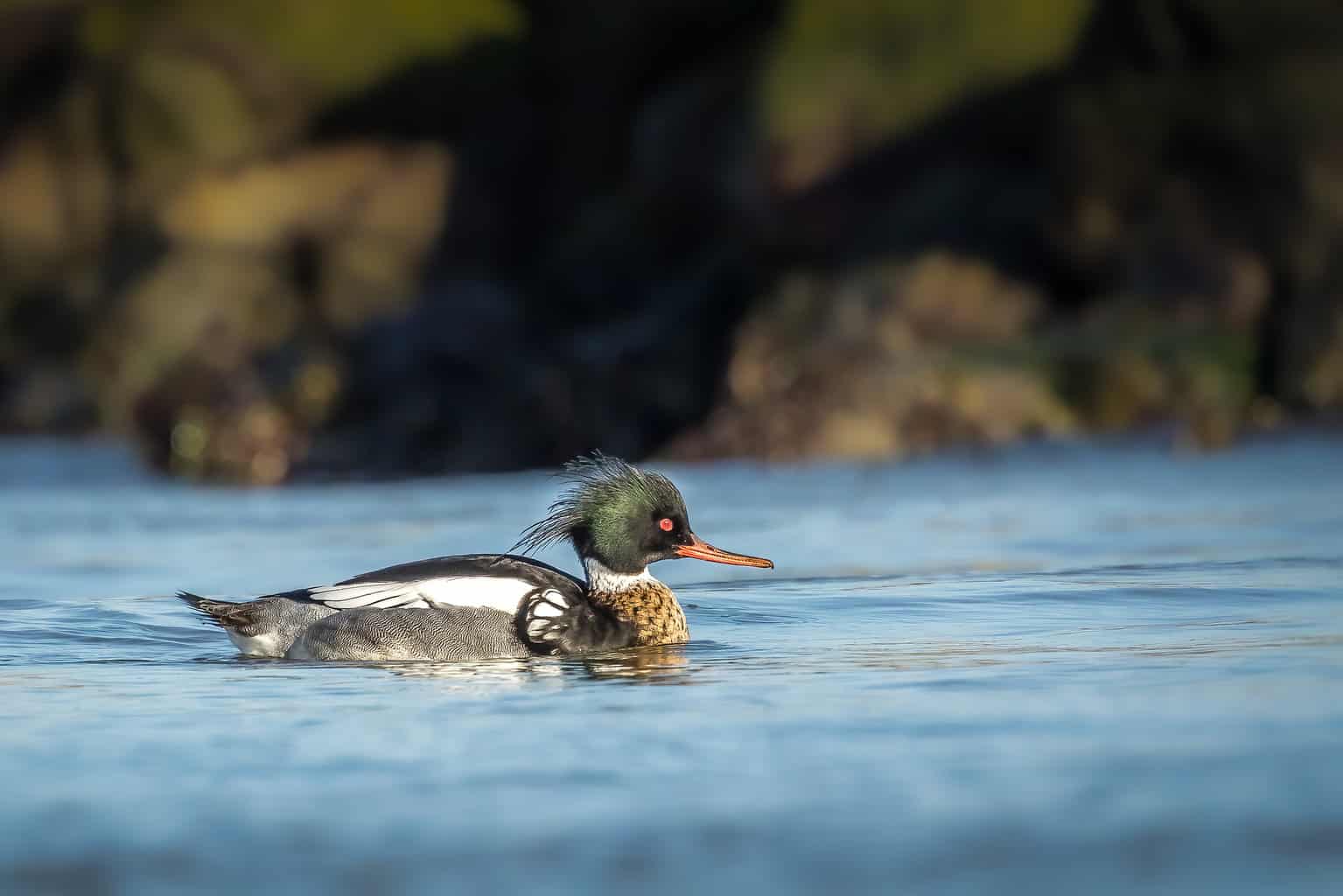
- Scientific Name: Mergus serrator
- Length: 20 – 24 inches
- Weight: 29 – 35 oz
- Wingspan: 28 – 34 inches
The beautiful Red-breasted Merganser is a rare sight in South Dakota, but a few birds can be seen during the colder months, between November and April.
The amazing-looking spiky crests of males and females give this Merganser a special style, and it’d be hard not to be charmed by the male’s gorgeous green head and thick white collar.
Adept hunters, Red-breasted Mergansers are highly-skilled at catching fish, but will also eat crustaceans, amphibians, and insects.
Long-tailed Duck
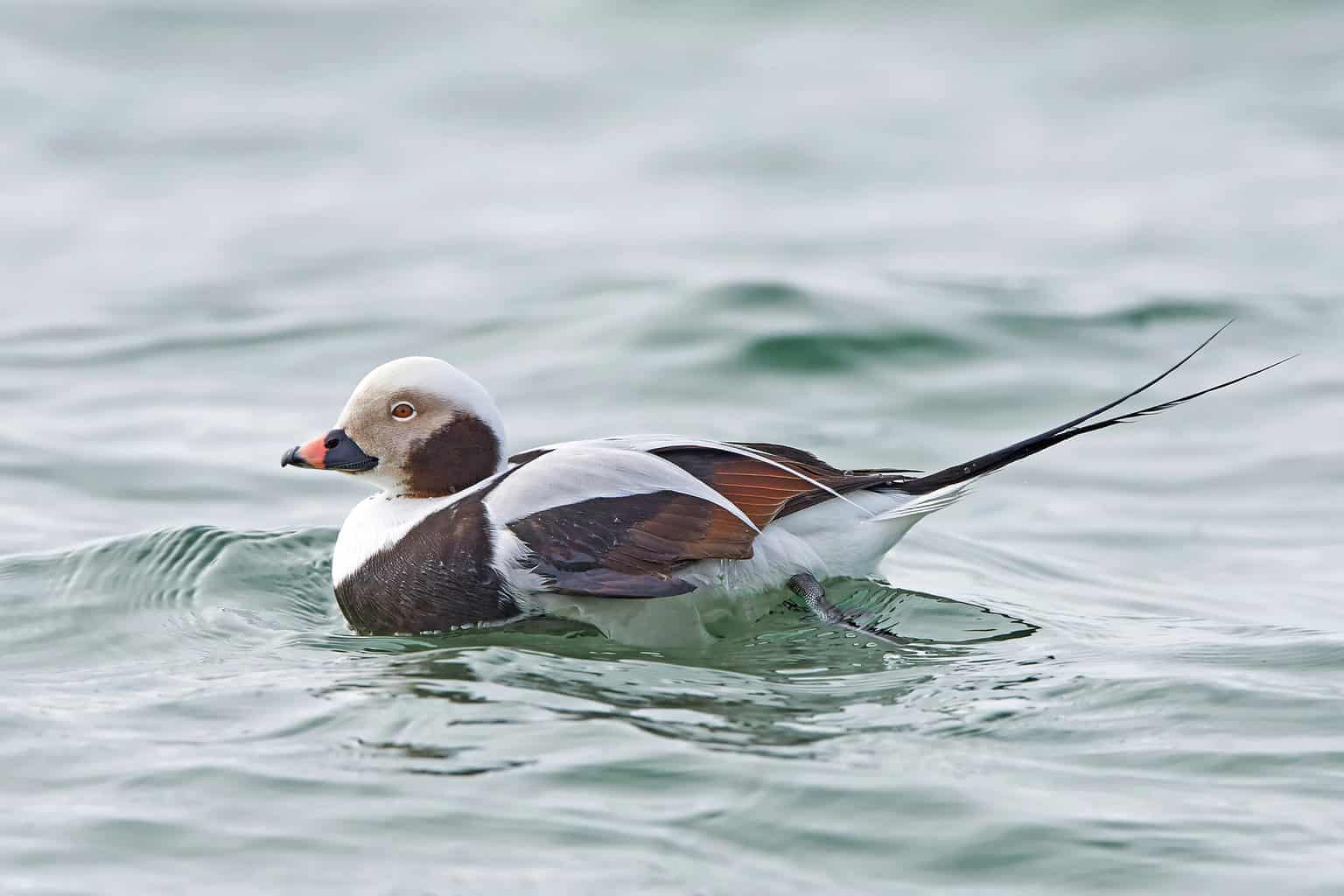
- Scientific Name: Clangula hyemalis
- Length: 15 – 22 in
- Weight: 31.74 oz
- Wingspan: 26 – 31 in
Long-tailed Ducks should be considered a prized spotting in South Dakota, as they’re seen by less than 1% of bird watchers here. A few of them do, however, spend their winters in the state, before returning to their more northerly breeding grounds.
Formerly known as ‘Oldsquaw’, Long-tailed ducks are exotic-looking ducks with extremely long, pointed tail feathers that earned them their common name.
They’re also the champion among ducks in their diving capabilities, which sadly sometimes get caught in fishermen’s nets in coastal areas. Some fishermen have reported catching them in nets as deep as 180 feet underwater!
Conclusion
There’s a wide variety of duck species that can be spotted in South Dakota throughout the year.
While the spring and autumn migratory seasons are the best times to see ducks here, many species also reside in the state during the summer, winter, or even all year round.
To check out more of the fascinating birds that can be spotted in South Dakota, don’t miss our guide to 26 of the most impressive species here.

